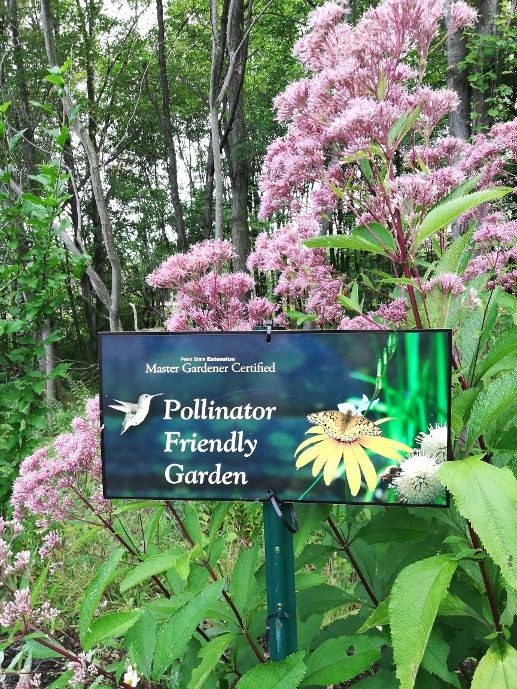Posted: June 13, 2021
We need pollination to occur, and we rely on our pollinators to make it happen. This eye-opening quote attributed to Albert Einstein sums up why we need pollinators: "If the bee disappears from the surface of the earth, man would have no more than four years to live."

Photo by Judy Coleman
Pollinators all over the world are in decline, including our native bees and honey bees. Their decline is due to loss of habitat and food sources as well as increased use of pesticides and extreme weather patterns related to climate change.
Pollination is the process of transferring pollen from the male part of a flower (anther) to the female part (stigma). The transfer of pollen in and between flowers of the same species leads to fertilization and successful seed and fruit production for plants. Pollination ensures that a plant will produce full-bodied fruit and a full set of viable seeds.
When we hear the word pollinators, most of us think of bees and butterflies. However, they are not the only pollinators. Beetles, hummingbirds, birds, ants, moths, caterpillars, and even bats are pollinators. Bats and moths pollinate at night.
Entomologist Doug Tallamy's research concludes that without insect pollinators, 80% of all plants and 90% of all flowering plants would disappear; His message is clear: there will be no lions, tigers, or bears, birds, bats, or bunnies--or humans--in a world without insects.
So, how do we help support our pollinators? Here are some steps you can incorporate into your gardening practices.
1. Choose native plants.
Native plants provide pollinators with an essential food source. Pollinators and their larvae are specialized eaters. Most only eat from specific plants and they have different needs throughout the year. The unavailability of certain plants can throw off the ecosystems that support pollinators.
What is a native plant? They are plants that occur naturally in a geographic area. They were not introduced, imported, or transplanted by humans. Native plants are acclimated to their geographic region's climate, soil, rainfall, the availability of pollinators, and seed dispersal. Native plants include shrubs, trees, grasses, annual and perennial flowers.
Many native plants are host plants where butterflies and moths lay their eggs. Most of us know that the monarch butterfly caterpillars eat milkweed; it is the monarch's host plant. Butterfly larvae, or caterpillars, feed on the host plants for their nutrition. Remember they are specialized eaters and many only eat specific native plants.
Most non-native plants do not provide food for larval stages of pollinators.
2. Remove invasive plants from your landscape.
Reduction of pollinator habitat is not only a result of urbanization--but it is also because of the introduction of invasive plants. Invasive species are plants that were brought from other regions or countries; they are not native to our area. These plants often have prolific reproduction, crowding out native plants. This, in turn, threatens and reduces pollinator habitat.
Some of the most common invasive plants here in northeast Pennsylvania include the Callery (flowering) pear tree, burning bush, butterfly bush, English ivy, tree of heaven, oriental bittersweet, and Japanese knotweed.
3. Don't serve poison to our pollinators.
The use of pesticides and chemicals inadvertently kills beneficial insects like pollinators and may travel up the food chain to birds and small mammals.
Chemicals and pesticides are sold to homeowners to promote and enhance lush lawns, to kill weeds and insects. The dandelion has become villain #1, and homeowners are encouraged to destroy them. However, despite the fact that it is not a native plant, dandelions are one of the few early-blooming spring pollen sources for bees.
By treating your lawn, you are killing pollinator's eggs, larva, pupa, and adults. Many bees are solitary and nest in loose soil. There are times when chemicals or pesticides are the only option, but they should only be used as a last resort.
4. Leave the fall cleanup until the spring.
Pollinators need nesting sites; keep some piles of leaves for the bumblebee queens or those woolly caterpillars who often overwinter in leaf litter. Wait until temperatures reach a consistent 50 degrees, before you remove the leaves.
To find out how you can make your own garden a certified pollinator-friendly garden visit:
Penn State Pollinator Friendly Garden Certification.
Other great resources:
PA Department of Conservation & Natural Resources, dcnr.pa.gov
Ladybird Johnson's Wildflower Center
~by Michele Davis, Lackawanna County Master Gardener

